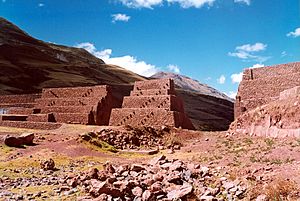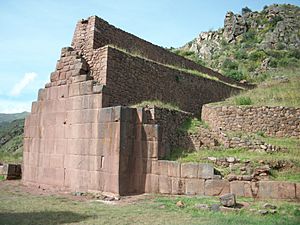Rumicolca facts for kids

View of Rumicolca
|
|
| Location | Lucre District, Quispicanchi Province, Cusco Region, Peru |
|---|---|
| Region | Andes |
| Coordinates | 13°37′05″S 71°42′26″W / 13.61806°S 71.70722°W |
Rumicolca is an ancient archaeological site located in Peru. Its name might come from the Quechua language, where rumi means stone and qullqa means a place to store things, like a warehouse. This important site is found in the Cusco Region, specifically in the Lucre District of the Quispicanchi Province. Rumicolca is close to other old sites like Chuqi Pukyu and Pikillaqta, and it's just east of Lake Huacarpay.
Contents
Stories About Rumicolca
People have told many stories about how Rumicolca came to be. One popular tale from Cusco folklore explains its creation:
The Wari and the Water Challenge
Long ago, the Wari people lived in the city of Pikillaqta. The Wari were a powerful civilization that existed before the Inca, from about 550 to 900 A.D. They were known for building large cities and were the first to create a state-level society in the mountains of Peru.
Because Pikillaqta was a big city, the Wari needed a lot of water. A great Wari leader decided to solve this problem with a competition. He offered his only daughter's hand in marriage to the man who could bring water to Pikillaqta.
Two men wanted to marry his daughter. One was from Cusco, and the other was from Puno. Both started planning how to bring water to the city. The man from Cusco decided to build a huge canal from the Laguna de Huacarpay (Huacarpay Lake) to Pikillaqta. To do this, he had to cross a wide gap. So, he built a very large aqueduct, which is like a bridge that carries water. This amazing structure, known as La Portada de Rumicolca, still stands today.
What Was Rumicolca Really For?
For a long time, people have wondered about the main purpose of Rumicolca. Was it a gate, an aqueduct, or both? Here are the main ideas:
The Gate Idea
One idea was that Rumicolca was first built by the Wari people to act as a gate to their territory. Later, the Inca Empire, which came after the Wari, built an even bigger gate on top of the old Wari foundations.
This Inca gate was thought to separate the four main regions, called "suyus," of their vast empire. Specifically, Rumicolca was believed to be the gate between the northern region of Cusco and the southern region of Puno. Since it was on the main road connecting these two areas, travelers would have had to pass through it and pay a toll to the Inca. This idea also suggested that the Inca changed Rumicolca to work as an aqueduct too. This theory tried to explain why parts of Rumicolca look like rough Wari stonework, covered by finely carved Inca stone.
The Aqueduct Idea
The most accepted idea today is that Rumicolca was originally built as an aqueduct by the Wari people. This is similar to the old Cusco legend. Later, the Inca Empire took over the site and made improvements to the structure.
Experts like Kenneth Wright, who studies ancient water systems, say that the original structure definitely looks like Wari work. Also, the canal that runs along Rumicolca seems to be part of the original design, not something added later. This idea doesn't fully explain if it was also used as a gate. However, since it was on the main road from Cusco, it's very likely that travelers would have passed through it. In fact, building the aqueduct might have been done in a way that allowed water to reach Pikillaqta without stopping traffic on the important road.
See also
 In Spanish: Rumicolca para niños
In Spanish: Rumicolca para niños



